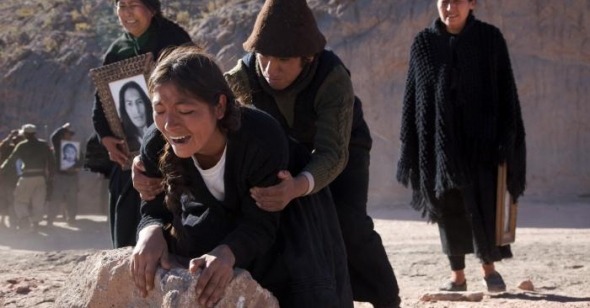Up to the Mountain
By Michael Koresky
Altiplano
Dir. Peter Brosens and Jessica Woodworth, Belgium/Germany/Netherlands, First Run Features
International culture-clash movie narratives used to be about bridging gaps, language barriers, righting wrongs, learning, healing. How times have changed. Today, global discontent has bred a severe alteration in such portraiture, resulting in an endless flow of grim scenarios that are no less myopic for being harrowing and unresolved. The smaller our world has grown, the tighter our financial, social, and political concerns have become, the more distrustful the narratives. Two or more disparate civilizations coming together onscreen is now often the catalyst for distrust, melancholy, and often, finally outright disaster. As evidenced by films such as Babel and Mammoth, a reason for this might have less to do with the filmmakers’ philosophy or geopolitics than simple storytelling opportunism—tragedy is easier than comedy, death and trauma simpler to telegraph than genuine harmony (Before the Rain may have been a game-changer in this regard, but at least that film’s central theme was grounded in the vital wartime reality of its Balkan setting.) Protest scenes are easier to stage—emotionally, at least—than moments of benevolent human exchange; it takes less imagination to film a crestfallen woman staring at the incomprehensible, uncaring world from the side of a cliff, her hair blowing in the unforgiving wind, her cheeks streaked with tears, than to chart her daily, gradual growing awareness and acceptance of life’s harsh realities.
We get a lot of close-ups of women staring off wretchedly into the distance in Altiplano, the new film from the international directing and producing team of the Belgian Peter Brosens and American Jessica Woodworth that takes place in the Peruvian Andes. These pensive, painful visages belong largely to two main characters: the nobly plainspoken and simple Saturnina (Magaly Solier), an impoverished Peruvian woman preparing for marriage to the nobly plainspoken and simple Ignacio (Edgar Quispe), and Grace (Jasmin Tabatabai), a Belgian former war photographer whose eye-doctor husband, Max (Dardennes’ mainstay Olivier Gourmet), has arrived in the Andes to treat the natives. Diligent watchers of heavily symbolic drama will note the centrality of the profession of optometry here, but that’s just the tip of the metaphorical iceberg in Altiplano, which, after more than an hour of largely realist cause-and-effect drama that lays out the interconnection of these characters, evolves (or devolves, depending on the viewer’s level of kindness) into a succession of disassociated, heightened, dreamlike images, even replacing a formerly tranquil soundtrack with operatic bombast. The film’s foregrounding of religious sacrifice, environmental contamination, and capitalist destruction ultimately provide fodder for a series of tableaux that, with their artfully arranged static bodies and hidden faces, seem little more than snapshots from a third-world masked ball.
But before Alitplano sails off into its own inner consciousness—a development that comes as both a relief (from the tiresome constraints of the preachy narrative) and a frustration (at the filmmakers’ inability to finally wrestle with the people it has thrust into such unremitting bleakness)—it at least invokes real-world anger. Silver mining operations from corporate gringos—or “pishtacos,” as the locals angrily dub them, a reference to a Peruvian tall tale of thieving bogeymen—in the town of Turubamba have led to an outbreak of mercury poisoning, which ultimately affects Saturnina’s mother and fiancé. As envisioned by Brosens and Woodworth, Saturnina and her family’s narrative is one of innocent, exalted suffering, complete with presumably indigenous musical wails on the soundtrack and careful, patient tracking shots by cinematographer Francisco Gozon that serve to heighten the natives’ purity and oneness with nature.
Saturnina may be a construct—and as embodied by The Milk of Sorrow’s Solier (as natural at victimhood here as she was in that Oscar-nominated film about a young girl who carries a potato in her vagina as defense against further rape), she is stoic beyond compare—but Grace is no less so. Following a portentous prologue in which a statue of the Virgin Mary is accidentally dropped and smashed during a church ceremony (that can’t bode well . . .), the film introduces us to Grace via her most catastrophic memory: as a photo journalist in Iraq, a masked militant had held a knife to her throat, while his accomplice demanded that she take a photo of her guide, Omar, being shot. The filmmakers depict this with queasy flourish, all in one creeping, circular take that begins on the back of Omar’s head and ends behind Grace’s. This horrific experience—the product of which she ultimately withdraws from Pulitzer consideration—naturally contaminates her life, as well as the narrative with questions of vision and the value of documenting truth (a discarded and reconstituted camcorder later comes into play). When placed within the whole doomed tapestry, Grace’s traumas seem writerly, an academic way into an overdetermined story, and perhaps needlessly grotesque. And when the event that finally unites Saturnina and Grace (at least spiritually) occurs, it feels like a thuddingly symbolic act rather than random violence, as intended.
Ultimately, the filmmakers seem less interested in these women than in getting the right Vermeer–like glow of burnished sunlight to stream from a window onto Saturnina as she is methodically put into her wedding dress, or ensuring that Ignacio’s first nosebleed brightly pops when placed against the vivid red of an enormous painted steel bridge. It’s the kind of film that’s so rigidly telegraphed that it makes passion (political and artistic) feel inert. Brosens and Woodworth may have been inspired by the people and landscape of Peru, but ultimately they’ve made another detached portrait of European ennui.
